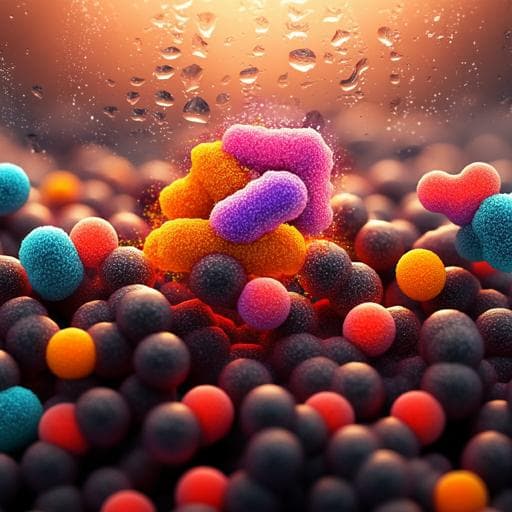
Environmental Studies and Forestry
Performance and mechanisms of greywater treatment in a bio-enhanced granular-activated carbon dynamic biofilm reactor
Z. Wang, Y. Yang, et al.
Discover the innovative BhGAC-DBfR, a bio-enhanced reactor developed for effective on-site graywater treatment, achieving outstanding removal rates for various pollutants. This research, conducted by Ziqi Wang, Ying Yang, Wanchen Xiang, Beibei Wu, Xiaocai Cui, and Yun Zhou, showcases a groundbreaking low-energy technology.
~3 min • Beginner • English
Introduction
The study addresses the need for efficient, low-energy on-site treatment of source-separated greywater, which constitutes 50–80% of domestic sewage and contains nitrogen, pathogens, micropollutants, and high concentrations of linear alkylbenzene sulfonates (LAS). Traditional aerated biological systems face foaming due to LAS and low oxygen transfer/utilization, raising costs and risking biomass loss. Oxygen-based membrane biofilm reactors (O2-MBfR) improve oxygen transfer and simultaneous organics/nitrogen removal but require pressurized air, membrane maintenance, and anti-fouling measures, increasing costs. Granular activated carbon (GAC) offers high porosity and adsorption, supporting biofilm growth and acting as a pollutant transfer and storage medium, enabling combined filtration, adsorption, catalysis, and biodegradation. The hypothesis is that a GAC-based dynamic biofilm reactor with distinct unsaturated and saturated zones can self-supply oxygen via gravity flow, establish aerobic–anoxic–anaerobic biofilm stratification, and achieve efficient simultaneous removal of organics (including LAS) and nitrogen with low energy input.
Literature Review
Prior greywater treatments include physical, chemical, biological, and hybrid processes, but on-site systems often suffer from low effluent quality and high energy demand. Traditional aeration in the presence of LAS causes foaming and biomass washout, with inefficient oxygen transfer. O2-MBfR avoids foaming and achieves high O2 transfer and effective organics/N removal, yet its reliance on pressurized air, membrane integrity management, and anti-blocking maintenance raises costs. GAC biofilters are widely used in wastewater treatment due to large surface area, adsorption capacity, and as biofilm carriers, enabling combined adsorption and biodegradation. Protein- and carbohydrate-rich EPS can enhance LAS accumulation and protect microbial functions short-term from LAS toxicity. However, knowledge gaps remain regarding biofilm formation on GAC, physicochemical properties, microbial ecology, and functional genes/enzymes for organics and nitrogen removal during greywater treatment, motivating the present study.
Methodology
Reactor design and operation: A lab-scale cylindrical BhGAC-DBfR (internal diameter 6.0 cm; effective height 67 cm; empty volume 1.90 L; water-holding volume 0.92 L when filled with GAC) was fed from the top by peristaltic pump to create gravity-driven flow forming unsaturated and saturated regions. The saturated depth was set by outlet height. The system operated in three phases with saturated/unsaturated volume ratios of 1:2.3, 1:1.1, and 1:0.58 (reported elsewhere as approximately 1:0.5), each at HRT 6.7 h. Functional zones were defined by DO: oxygen flushing zone (DO > 0.5 mg/L), transition zone (DO 0.2–0.5 mg/L), and anaerobic zone (DO < 0.2 mg/L, mainly bottom). Unsaturated flow provided natural O2 supply; DO decreased across biofilm depth promoting aerobic–anoxic–anaerobic stratification. DO, hydraulic loading rates (HLR), and organic loading rates (OLR) varied with phase; representative DO (mean ± SD) for influent/stratification/effluent were about 0.00/1.71/0.26 mg/L (Phase I), 0.01/1.24/0.15 mg/L (Phase II), and 0.00/0.84/0.08 mg/L (Phase III). GAC media: Acid-washed coconut husk GAC (2.0–3.2 mm) was rinsed and pre-seeded by soaking 3 h in diluted activated sludge (10 mL AS at 4.56 g TSS/L to 2 L tap water). Greywater: Synthetic greywater (25× concentrate per NSF/ANSI 350) was prepared to simulate bathing/laundry wastewater, diluted 25× for feed, pH adjusted to 7.05 ± 0.05, and stored at 4 °C. Batch adsorption/biodegradation tests: Three GAC types were tested—fresh GAC, bio-enhanced GAC (taken from top of unsaturated zone at Phase III steady state, day 140), and inactivated biofilm-GAC (bio-enhanced GAC inactivated with HgCl2 at 30 mg/g dry biomass). Triplicate 500 mL flasks each received 135.7 g wet GAC (60.5% moisture) and 200 mL triple-diluted greywater; shaking at 200 rpm, 21 ± 1 °C for 24 h in the dark. Samples were taken at 5, 10, 20, 30 min and 1, 2, 4, 8, 12, 24 h for LAS. Kinetic modeling: Adsorption modeled with pseudo-first-order and pseudo-second-order kinetics; active biofilm biodegradation modeled as first-order decay (dC/dt = −kBiod C). Parameters (k1, k2, kBiod, qe) estimated by minimizing sum of squared errors using Excel Solver. Sampling and analyses: Periodic sampling from influent, stratification, and effluent for COD, LAS, TN, NH4+-N, NO2−-N, NO3−-N, pH, and DO. LAS measured by methylene blue spectrophotometry; nutrients per Standard Methods/HACH kits; DO by portable DO meter; pH by pH meter. Biofilm characterization included SEM-EDX for morphology/elemental composition; FTIR (600–2000 cm−1, 5 cm−1 resolution, 16 scans) and 2D-COS for functional groups; biomass components (protein by Coomassie blue, carbohydrate by phenol-sulfuric acid, DNA by diphenylamine colorimetry). Microbial community: DNA extracted with DNeasy PowerSoil; 16S rRNA amplicon sequencing on Illumina NextSeq 500; processed with QIIME2/DADA2; taxonomy assigned with GreenGenes (99% similarity); community analyses by PCoA (Bray-Curtis). Functional potential predicted by PICRUSt2 mapping to KEGG. Statistics: Triplicate measurements; results as mean ± SD; one-way ANOVA (P < 0.05) performed in OriginPro.
Key Findings
- Optimal performance at saturated/unsaturated ratio of 1:1.1 (Phase II): maximum removals of COD (~98.0–98.3%), LAS (up to 99.4%; 98.4% during Phase II operation), NH4+-N (~99.3–99.8%), and TN (83.5%). Most removal occurred in the unsaturated zone, with the saturated zone providing polishing.
- Oxygen dynamics: Increasing the saturated proportion decreased oxygenation height/time and DO, especially in Phase III (stratification DO ~0.84 ± 0.02 mg/L; effluent DO ~0.08 ± 0.01 mg/L), leading to incomplete organics biodegradation and ammonia oxidation at very high saturated/unsaturated ratios.
- Biofilm growth and composition: Biomass (protein, carbohydrate, DNA) increased with higher saturated/unsaturated ratios and was highest at the top; SEM-EDX showed increased N, O, P and detectable S on GAC with biofilm. FTIR/2D-COS indicated functional groups (e.g., C–O, C=O, N–H, aliphatic ketone) conducive to adsorption/accumulation of organics and nitrogen.
- LAS removal mechanisms: Adsorption dominated initial rapid uptake; biodegradation sustained removal. Pseudo-first-order adsorption best fit fresh and inactivated GAC. In bio-enhanced GAC, a two-step model (biofilm adsorption + biodegradation) fit well (P < 0.01), yielding a LAS biodegradation rate constant kBIOD = 0.0580 h−1. Biofilm attachment slightly reduced GAC adsorption capacity versus fresh GAC.
- Nitrogen pathways: ON hydrolyzed to NH4+-N; nitrification occurred in aerobic layers; denitrification (aerobic and anaerobic) proceeded in inner layers, facilitated by enzymes NAR, NIR, NOR, NOS; glutamine synthetase also abundant. Effluent TN was dominated by refractory organic N (ON ~80.3% of effluent TN).
- Microbial ecology: Top and stratification biofilms clustered similarly and were dominated by alpha- and gamma-Proteobacteria, supporting organics oxidation and nitrogen transformations; Nitrospira presence was stable, supporting ammonia removal. Bottom biofilms formed distinct clusters with more anaerobic taxa (e.g., Desulfovibrionales, Rhodospirillales, Oceanospirillales) under lower DO. Predicted enzyme abundances for LAS metabolism and N cycling were highest at the top; denitrification-related enzymes increased under lowest DO (high saturated fraction).
- Process performance distribution: In Phase I, the oxygen flushing zone achieved ~81.1% COD and 85.3% TN removal; subsequent zones further reduced organics and nitrogen to ~6.6% and 4.0% of influent, respectively. LAS was a small fraction of residual organics (≤1.2% in stratification effluent; ~0.97% in final effluent).
Discussion
The BhGAC-DBfR leveraged gravity-driven oxygenation to establish an aerobic–anoxic–anaerobic biofilm across GAC particles, enabling simultaneous and efficient removal of organics (including LAS) and nitrogen. Partitioning the reactor into unsaturated and saturated regions maximized oxygen utilization without energy-intensive aeration, with most treatment occurring in the unsaturated oxygen flushing zone and the saturated zone serving as a polishing step. The coexistence of adsorption (rapid uptake) and biodegradation (sustained removal) was critical: GAC and biofilm functional groups provided immediate LAS and organics capture, while biofilm communities and enzymes mineralized LAS and transformed nitrogen via nitrification-denitrification across microenvironments. Microbial community structure and predicted functional enzymes corroborated observed performance, with aerobic taxa and nitrifiers/denitrifiers enriched where DO was higher, and anaerobes prevailing at the bottom under low DO. The findings validate the hypothesis that a self-oxygenating GAC-based dynamic biofilm can achieve high removals with low energy input, addressing the limitations of conventional aeration (foaming, low O2 transfer) and membrane systems (costly pressurization/maintenance).
Conclusion
An easy-to-maintain, energy-efficient BhGAC-DBfR was developed for on-site greywater treatment. Adjusting saturated/unsaturated zones promoted biofilm growth and functional stratification, achieving maximum removals at a 1:1.1 ratio: COD ~98%, LAS up to 99.4%, NH4+-N up to 99.8%, and TN 83.5%. Adsorption and biodegradation had complementary roles in rapid uptake and sustained removal of organics and nitrogen. Microbial and enzymatic analyses confirmed the presence of taxa and functions supporting LAS mineralization, organic N deamination, nitrification, and denitrification. The reactor offers a promising low-energy alternative for decentralized greywater and potentially other wastewaters. Future work should address operation with real greywater (fouling/clogging control, e.g., pre-straining), management of antibiotic resistance genes associated with surfactant-rich wastewaters, long-term stability, scale-up, and optimization of saturated/unsaturated ratios under varying loads.
Limitations
The study used synthetic greywater; real greywater containing hair and solids may cause clogging and affect biofilm stability and treatment performance, necessitating pre-strainers. High LAS concentrations may promote antibiotic-resistant bacteria and resistance genes, potentially affecting effluent quality; ARG proliferation and control were not directly quantified. Reported saturated/unsaturated ratios varied across sections; operational variability may influence DO profiles and performance. Long-term membrane-like integrity issues are avoided, but long-term GAC exhaustion or fouling and maintenance requirements were not evaluated beyond five months.
Related Publications
Explore these studies to deepen your understanding of the subject.







